Effects of Quercetin and Curcumin Combination on Antibacterial, Antioxidant, In Vitro Wound Healing and Migration of Human Dermal Fibroblast Cells
Abstract
:1. Introduction
2. Results
2.1. Antibacterial Activity of Quercetin, Curcuminoids and Quercetin/Curcuminoid Mixtures
2.2. Effects of Quercetin, Curcuminoids and Quercetin/Curcuminoid Mixtures on DPPH and ABTS Free Radical Scavenging
2.3. Cytotoxicity of Quercetin, Curcuminoids and Quercetin/Curcuminoid Mixtures
2.4. Effects of Quercetin, Curcuminoids and Quercetin/Curcuminoid Mixtures on Wound Closure
2.5. Effects of Quercetin, Curcuminoids and Quercetin/Curcuminoid Mixtures on HDFB Cell Migration
3. Discussion
4. Materials and Methods
4.1. Determination of Antibacterial Activities of Quercetin, Curcuminoids and Quercetin/Curcuminoid Mixture
4.2. In Vitro Antioxidant Assay by DPPH Method
4.3. In Vitro Antioxidant Assay by ABTS Method
4.4. Cell Culture
4.5. Cell Viability Assay
4.6. In Vitro Scratch Assay
4.7. Transwell Migration Assay
4.8. Statistical Analysis
5. Conclusions
Author Contributions
Funding
Institutional Review Board Statement
Informed Consent Statement
Data Availability Statement
Acknowledgments
Conflicts of Interest
References
- Guo, S.; DiPietro, L.A. Factors affecting wound healing. J. Dent. Res. 2010, 89, 219–229. [Google Scholar] [CrossRef] [PubMed]
- Järbrink, K.; Ni, G.; Sönnergren, H.; Schmidtchen, A.; Pang, C.; Bajpai, R.; Car, J. Prevalence and incidence of chronic wounds and related complications: A protocol for a systematic review. Syst. Rev. 2016, 5, 152. [Google Scholar] [CrossRef] [PubMed] [Green Version]
- Landén, N.X.; Li, D.; Ståhle, M. Transition from inflammation to proliferation: A critical step during wound healing. Cell. Mol. Life Sci. 2016, 73, 3861–3885. [Google Scholar] [CrossRef] [PubMed] [Green Version]
- Opneja, A.; Kapoor, S.; Stavrou, E.X. Contribution of platelets, the coagulation and fibrinolytic systems to cutaneous wound healing. Thromb. Res. 2019, 179, 56–63. [Google Scholar] [CrossRef]
- Ellis, S.; Lin, E.J.; Tartar, D. Immunology of wound healing. Curr. Dermatol. Rep. 2018, 7, 350–358. [Google Scholar] [CrossRef] [Green Version]
- Johnson, K.E.; Wilgus, T.A. Vascular endothelial growth factor and angiogenesis in the regulation of cutaneous wound repair. Adv. Wound Care 2014, 3, 647–661. [Google Scholar] [CrossRef] [Green Version]
- Misic, A.M.; Gardner, S.; Grice, E.A. The wound microbiome: Modern approaches to examining the role of microorganisms in impaired chronic wound healing. Adv. Wound Care 2014, 3, 502–510. [Google Scholar] [CrossRef] [Green Version]
- Dunnill, C.; Patton, T.; Brennan, J.; Barrett, J.; Dryden, M.; Cooke, J.; Leaper, D.; Georgopoulos, N.T. Reactive oxygen species (ROS) and wound healing: The functional role of ROS and emerging ROS-modulating technologies for augmentation of the healing process. Int. Wound J. 2015, 14, 89–96. [Google Scholar] [CrossRef]
- Comino-Sanz, I.M.; López-Franco, M.D.; Castro, B.; Pancorbo-Hidalgo, P.L. The role of antioxidants on wound healing: A review of the current evidence. J. Clin. Med. 2021, 10, 3558. [Google Scholar] [CrossRef]
- Doersch, K.M.; Newell-Rogers, M.K. The impact of quercetin on wound healing relates to changes in αV and β1 integrin expression. Exp. Biol. Med. 2017, 242, 1424–1431. [Google Scholar] [CrossRef] [Green Version]
- Chaniad, P.; Tewtrakul, S.; Sudsai, T.; Langyanai, S.; Kaewdana, K. Anti-inflammatory, wound healing and antioxidant potential of compounds from Dioscorea bulbifera L. bulbils. PLoS ONE 2020, 15, e0243632. [Google Scholar] [CrossRef]
- Gopalakrishnan, A.; Ram, M.; Kumawat, S.; Tandan, S.; Kumar, D. Quercetin accelerated cutaneous wound healing in rats by increasing levels of VEGF and TGF-β1. Indian J Exp. Biol. 2016, 54, 187–195. [Google Scholar] [PubMed]
- Fu, J.; Huang, J.; Lin, M.; Xie, T.; You, T. Quercetin promotes diabetic wound healing via switching macrophages from M1 to M2 polarization. J. Surg. Res. 2019, 246, 213–223. [Google Scholar] [CrossRef] [PubMed]
- Kulac, M.; Aktas, C.; Tulubas, F.; Uygur, R.; Kanter, M.; Erboga, M.; Ceber, M.; Topcu, B.; Ozen, O.A. The effects of topical treatment with curcumin on burn wound healing in rats. J. Mol. Histol. 2012, 44, 83–90. [Google Scholar] [CrossRef]
- Akbik, D.; Ghadiri, M.; Chrzanowski, W.; Rohanizadeh, R. Curcumin as a wound healing agent. Life Sci. 2014, 116, 1–7. [Google Scholar] [CrossRef] [PubMed]
- López-García, J.; Lehocký, M.; Humpolíček, P.; Sáha, P. HaCaT keratinocytes response on antimicrobial atelocollagen substrates: Extent of cytotoxicity, cell viability and proliferation. J. Funct. Biomater. 2014, 5, 43–57. [Google Scholar] [CrossRef] [Green Version]
- ISO: 10993-5:2009. Biological Evaluation of Medical Devices—Part 5: Tests for In Vitro Cytotoxicity; International Organization for Standardization: Geneva, Switzerland, 2009. [Google Scholar]
- Chittasupho, C.; Junmahasathien, T.; Chalermmongkol, J.; Wongjirasakul, R.; Leesawat, P.; Okonogi, S. Suppression of intracellular reactive oxygen species in human corneal epithelial cells via the combination of quercetin nanoparticles and epigallocatechin gallate and in situ thermosensitive gel formulation for ocular drug delivery. Pharmaceuticals 2021, 14, 679. [Google Scholar] [CrossRef]
- Musyarrofah, L.; Saepudin, E.; Rahayu, D.U.C. Acetylation of curcumin from turmeric rhizome (Curcuma longa) with Ni/SiO2 and pyridine catalysts and its antibacterial activity. AIP Conf. Proc. 2020, 2242, 040037. [Google Scholar] [CrossRef]
- Adamczak, A.; Ożarowski, M.; Karpiński, T.M. Curcumin, a natural antimicrobial agent with strain-specific activity. Pharmaceuticals 2020, 13, 153. [Google Scholar] [CrossRef]
- Razmavar, S.; Abdulla, M.A.; Ismail, S.B.; Hassandarvish, P. Antibacterial activity of leaf extracts of Baeckea frutescens against methicillin-resistant Staphylococcus aureus. BioMed Res. Int. 2014, 2014, 521287. [Google Scholar] [CrossRef] [Green Version]
- Yuan, G.; Guan, Y.; Yi, H.; Lai, S.; Sun, Y.; Cao, S. Antibacterial activity and mechanism of plant flavonoids to gram-positive bacteria predicted from their lipophilicities. Sci. Rep. 2021, 11, 10471. [Google Scholar] [CrossRef]
- Wang, S.; Yao, J.; Zhou, B.; Yang, J.; Chaudry, M.T.; Wang, M.; Xiao, F.; Li, Y.; Yin, W. Bacteriostatic effect of quercetin as an antibiotic alternative in vivo and its antibacterial mechanism in vitro. J. Food Prot. 2018, 81, 68–78. [Google Scholar] [CrossRef] [PubMed]
- Güran, M.; Şanlıtürk, G.; Kerküklü, N.R.; Altundağ, E.M.; Süha Yalçın, A. Combined effects of quercetin and curcumin on anti-inflammatory and antimicrobial parameters in vitro. Eur. J Pharmacol. 2019, 859, 172486. [Google Scholar] [CrossRef]
- Cushnie, T.P.T.; Lamb, A.J. Antimicrobial activity of flavonoids. Int. J. Antimicrob. Agents 2005, 26, 343–356. [Google Scholar] [CrossRef] [PubMed]
- Rai, D.; Singh, J.K.; Roy, N.; Panda, D. Curcumin inhibits FtsZ assembly: An attractive mechanism for its antibacterial activity. Biochem. J. 2008, 410, 147–155. [Google Scholar] [CrossRef] [Green Version]
- Yasuno, F.; Tanimukai, S.; Sasaki, M.; Ikejima, C.; Yamashita, F.; Kodama, C.; Mizukami, K.; Asada, T. Combination of antioxidant supplements improved cognitive function in the elderly. J. Alzheimer’s Dis. 2012, 32, 895–903. [Google Scholar] [CrossRef]
- Aftab, N.; Vieira, A. Antioxidant activities of curcumin and combinations of this curcuminoid with other phytochemicals. Phytother. Res. 2009, 24, 500–502. [Google Scholar] [CrossRef]
- Bentz, A.B. A Review of Quercetin: Chemistry, Antioxident Properties, and Bioavailability. 2017. Available online: https://www.jyi.org/2009-april/2017/10/15/a-review-of-quercetin-chemistry-antioxidant-properties-and-bioavailability (accessed on 21 December 2020).
- Barclay, L.R.C.; Vinqvist, M.R.; Mukai, K.; Goto, H.; Hashimoto, Y.; Tokunaga, A.; Uno, H. On the antioxidant mechanism of curcumin: Classical methods are needed to determine antioxidant mechanism and activity. Org. Lett. 2000, 2, 2841–2843. [Google Scholar] [CrossRef]
- Chen, W.F.; Deng, S.L.; Zhou, B.; Yang, L.; Liu, Z.L. Curcumin and its analogues as potent inhibitors of low density lipoprotein oxidation: H-atom abstraction from the phenolic groups and possible involvement of the 4-hydroxy-3-methoxyphenyl groups. Free Radic. Biol. Med 2006, 40, 526–535. [Google Scholar] [CrossRef]
- Somparn, P.; Phisalaphong, C.; Nakornchai, S.; Unchern, S.; Morales, N. Comparative antioxidant activities of curcumin and its demethoxy and hydrogenated derivatives. Biol. Pharm. Bull. 2007, 30, 74–78. [Google Scholar] [CrossRef] [PubMed] [Green Version]
- Błauż, A.; Pilaszek, T.; Grzelak, A.; Dragan, A.; Bartosz, G. Interaction between antioxidants in assays of total antioxidant capacity. Food Chem. Toxicol. 2008, 46, 2365–2368. [Google Scholar] [CrossRef] [PubMed]
- Boots, A.W.; Balk, J.M.; Bast, A.; Haenen, G.R. The reversibility of the glutathionyl-quercetin adduct spreads oxidized quercetin-induced toxicity. Biochem. Biophys. Res. Commun. 2005, 338, 923–929. [Google Scholar] [CrossRef]
- Murakami, Y.; Kawata, A.; Ito, S.; Katayama, T.; Fujisawa, S. Radical-scavenging and anti-inflammatory activity of quercetin and related compounds and their combinations against RAW264.7 cells stimulated with Porphyromonas gingivalis fimbriae. Relationships between anti-inflammatory activity and quantum chemical parameters. Vivo 2015, 29, 701–710. [Google Scholar]
- Iacopini, P.; Baldi, M.; Storchi, P.; Sebastiani, L. Catechin, epicatechin, quercetin, rutin and resveratrol in red grape: Content, in vitro antioxidant activity and interactions. J. Food Compos. Anal. 2008, 21, 589–598. [Google Scholar] [CrossRef]
- Paliwal, S.; Sundaram, J.; Mitragotri, S. Induction of cancer-specific cytotoxicity towards human prostate and skin cells using quercetin and ultrasound. Br. J. Cancer 2005, 92, 499–502. [Google Scholar] [CrossRef] [Green Version]
- Yamauchi, K.; Mitsunaga, T.; Afroze, S.H.; Uddin, M.N. Structure–activity relationships of methylquercetin on anti-migration and anti-proliferation activity in B16 melanoma cells. Anticancer Res. 2017, 37, 1575–1579. [Google Scholar] [CrossRef] [Green Version]
- Kim, S.-Y.; Jeong, H.-C.; Hong, S.-K.; Lee, M.-O.; Cho, S.-J.; Cha, H.-J. Quercetin induced ROS production triggers mitochondrial cell death of human embryonic stem cells. Oncotarget 2016, 8, 64964–64973. [Google Scholar] [CrossRef] [PubMed] [Green Version]
- Jang, S.; Chun, J.; Shin, E.M.; Kim, H.; Kim, Y.S. Inhibitory effects of curcuminoids from Curcuma longa on matrix metalloproteinase-1 expression in keratinocytes and fibroblasts. J. Pharm. Investig. 2012, 42, 33–39. [Google Scholar] [CrossRef]
- Cianfruglia, L.; Minnelli, C.; Laudadio, E.; Scirè, A.; Armeni, T. Side effects of curcumin: Epigenetic and antiproliferative implications for normal dermal fibroblast and breast cancer cells. Antioxidants 2019, 8, 382. [Google Scholar] [CrossRef] [Green Version]
- Scharstuhl, A.; Mutsaers, H.A.; Pennings, S.W.; Szarek, W.A.; Russel, F.G.; Wagener, F.A. Curcumin-induced fibroblast apoptosis and in vitro wound contraction are regulated by antioxidants and heme oxygenase: Implications for scar formation. J. Cell. Mol. Med. 2009, 13, 712–725. [Google Scholar] [CrossRef] [PubMed] [Green Version]
- Bao, D.; Wang, J.; Pang, X.; Liu, H. Protective Effect of quercetin against oxidative stress-induced cytotoxicity in rat pheochromocytoma (PC-12) cells. Molecules 2017, 22, 1122. [Google Scholar] [CrossRef] [PubMed]
- Kant, V.; Jangir, B.L.; Sharma, M.; Kumar, V.; Joshi, V.G. Topical application of quercetin improves wound repair and regeneration in diabetic rats. Immunopharmacol. Immunotoxicol. 2021, 43, 536–553. [Google Scholar] [CrossRef] [PubMed]
- Sukumaran, S.K.; Vadakkekuttical, R.J.; Kanakath, H. Comparative evaluation of the effect of curcumin and chlorhexidine on human fibroblast viability and migration: An in vitro study. Indian Soc. Periodontol. 2020, 24, 109–116. [Google Scholar] [CrossRef]
- Topman, G.; Lin, F.-H.; Gefen, A. The natural medications for wound healing–curcumin, aloe-vera and ginger–do not induce a significant effect on the migration kinematics of cultured fibroblasts. J. Biomech. 2013, 46, 170–174. [Google Scholar] [CrossRef] [PubMed]
- Buranasukhon, W.; Athikomkulchai, S.; Tadtong, S.; Chittasupho, C. Wound healing activity of Pluchea indica leaf extract in oral mucosal cell line and oral spray formulation containing nanoparticles of the extract. Pharm. Biol. 2017, 55, 1767–1774. [Google Scholar] [CrossRef] [Green Version]
- Chittasupho, C.; Athikomkulchai, S. Nanoparticles of Combretum quadrangulare leaf extract induce cytotoxicity, apoptosis, cell cycle arrest and anti-migration in lung cancer cells. J. Drug Deliv. Sci. Technol. 2018, 45, 378–387. [Google Scholar] [CrossRef]
- Chittasupho, C.; Kewsuwan, P.; Murakami, T. CXCR4-targeted nanoparticles reduce cell viability, induce apoptosis and inhibit SDF-1α induced BT-549-Luc cell migration in vitro. Curr. Drug Deliv. 2017, 14, 1060–1070. [Google Scholar] [CrossRef] [PubMed]
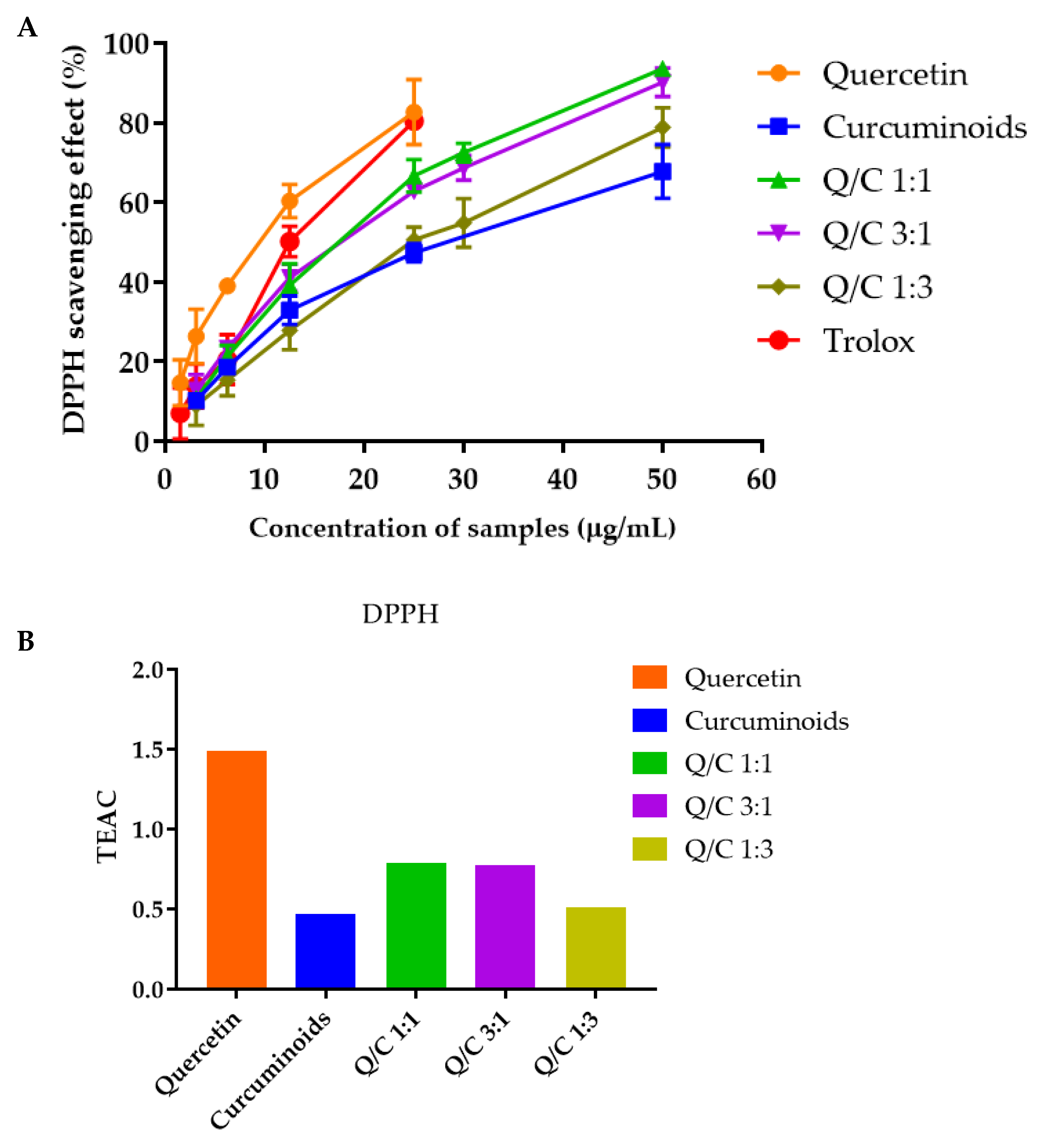
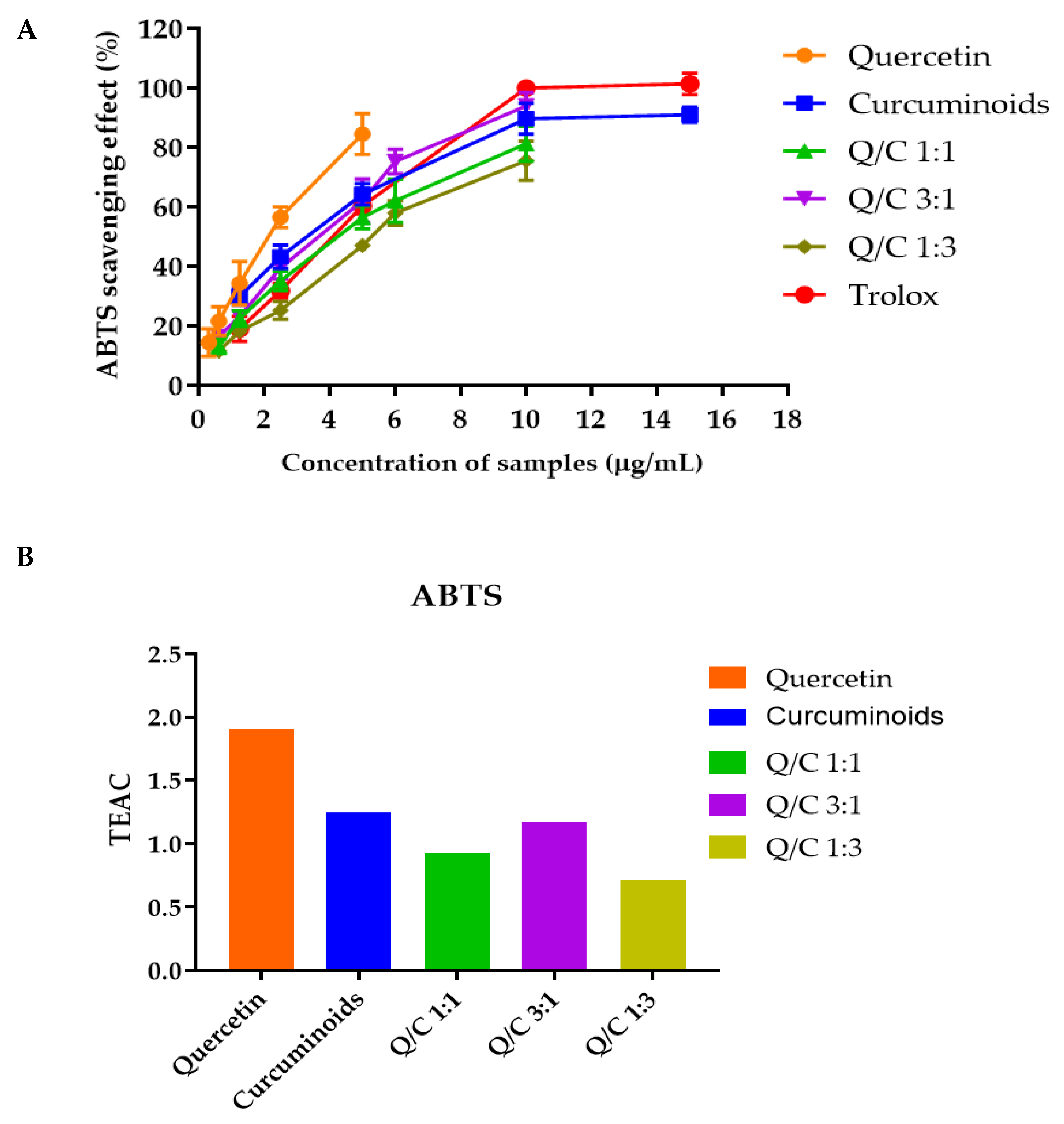
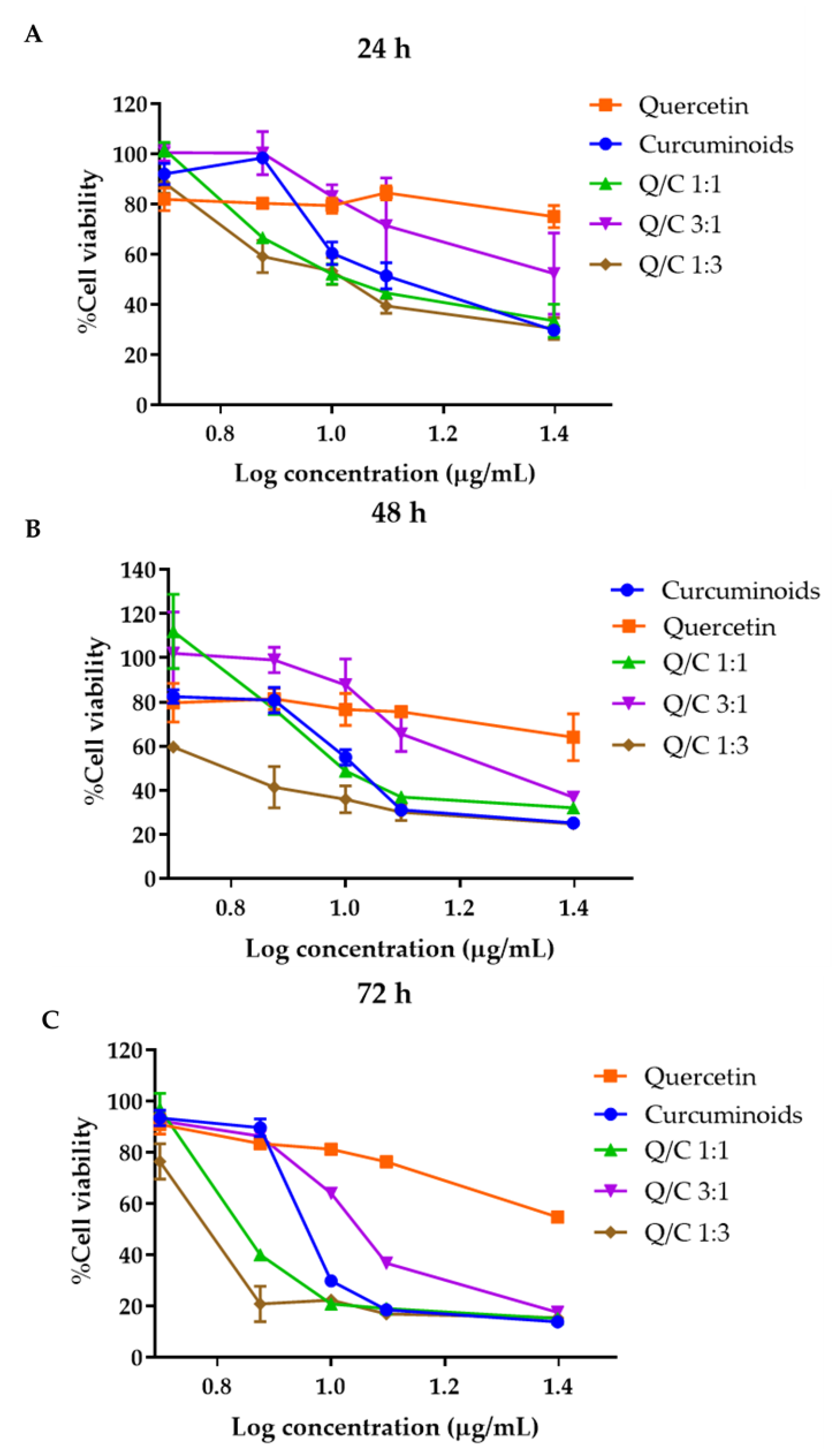
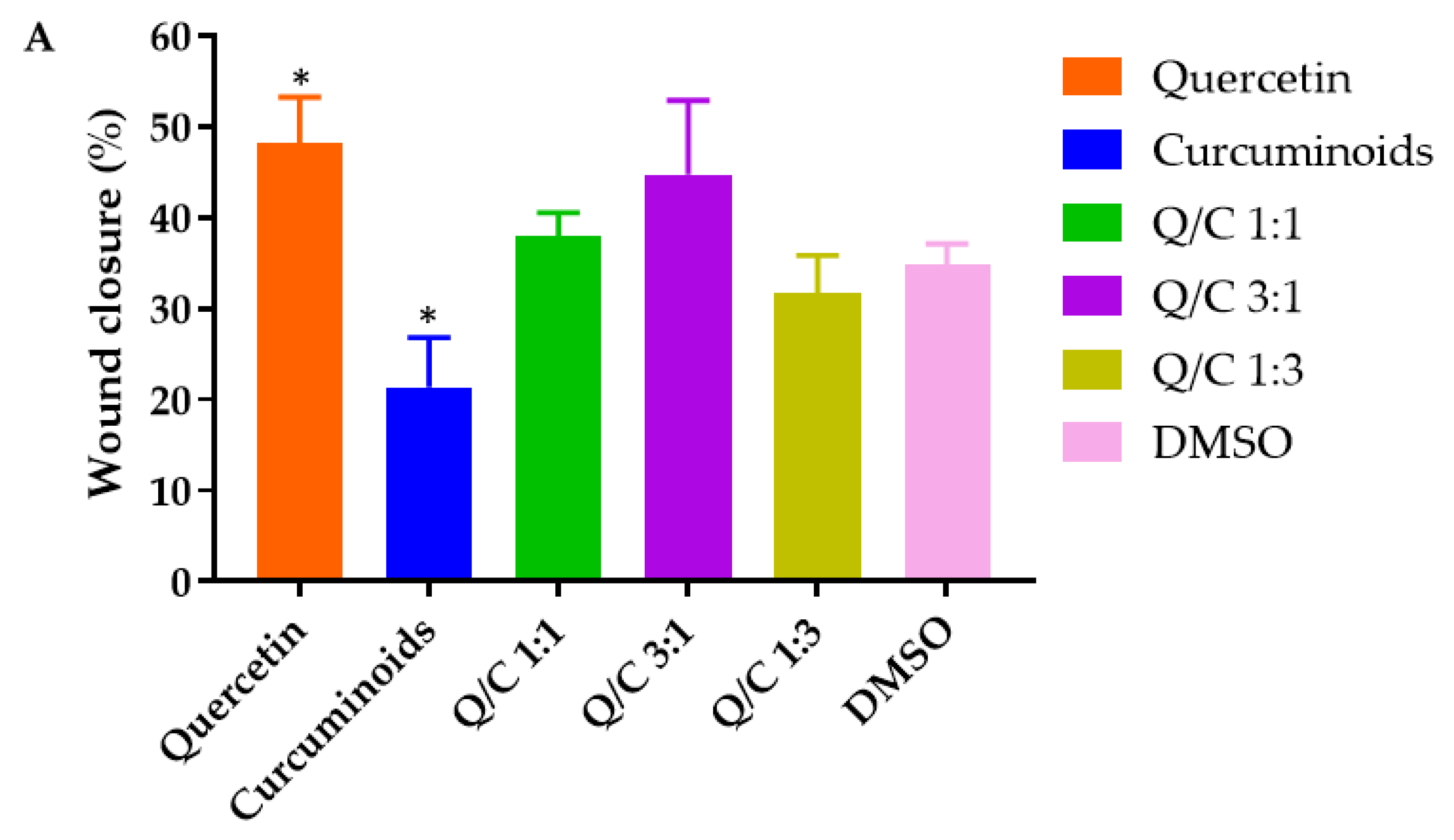
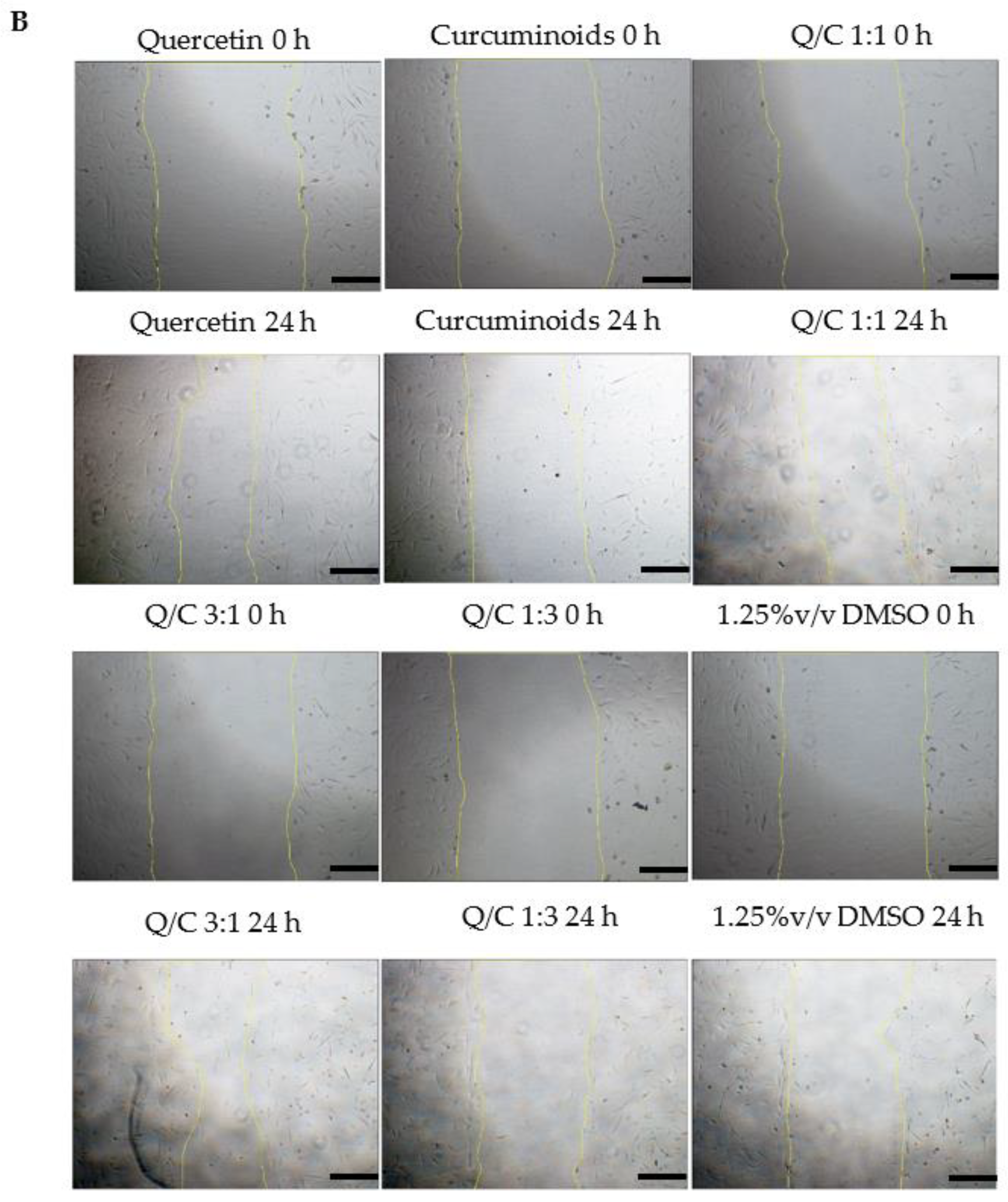

| Sample | Concentration (µg/mL) | S. aureus (DMST 8013) (mm) | P. aeruginosa (DMST 15501) (mm) |
|---|---|---|---|
| Quercetin | 250 | 0 | 0 |
| Curcuminoids | 250 | 0 | 0 |
| Q:C (1:1) | 250 | 8.78 ± 0.38 | 8.67 ± 0.00 |
| Q:C (3:1) | 250 | 8.33 ± 0.33 | 7.67 ± 0.33 |
| Q:C (1:3) | 250 | 7.22 ± 0.19 | 7.06 ± 0.25 |
| Neomycin sulfate (Positive control) | 100 | 15.33 ± 0.82 | 12.60 ± 0.63 |
| DPPH (µg/mL) | ABTS (µg/mL) | |
|---|---|---|
| Quercetin | 8.14 | 1.83 |
| Curcuminoids | 25.75 | 2.80 |
| Quercetin/Curcuminoids 1:1 | 15.38 | 3.78 |
| Quercetin/Curcuminoids 3:1 | 15.59 | 2.98 |
| Quercetin/Curcuminoids 1:3 | 23.70 | 4.88 |
| Trolox | 12.10 | 3.49 |
| 24 h | 48 h | 72 h | |
|---|---|---|---|
| Quercetin | >25 | >25 | 29.44 |
| Curcuminoids | 14.57 | 11.11 | 9.3 |
| Quercetin/Curcuminoids 1:1 | 12.6 | 11.52 | 7.437 |
| Quercetin/Curcuminoids 3:1 | 24.78 | 19.22 | 11.69 |
| Quercetin/Curcuminoids 1:3 | 11.24 | 6.694 | 6.271 |
Publisher’s Note: MDPI stays neutral with regard to jurisdictional claims in published maps and institutional affiliations. |
© 2021 by the authors. Licensee MDPI, Basel, Switzerland. This article is an open access article distributed under the terms and conditions of the Creative Commons Attribution (CC BY) license (https://creativecommons.org/licenses/by/4.0/).
Share and Cite
Chittasupho, C.; Manthaisong, A.; Okonogi, S.; Tadtong, S.; Samee, W. Effects of Quercetin and Curcumin Combination on Antibacterial, Antioxidant, In Vitro Wound Healing and Migration of Human Dermal Fibroblast Cells. Int. J. Mol. Sci. 2022, 23, 142. https://doi.org/10.3390/ijms23010142
Chittasupho C, Manthaisong A, Okonogi S, Tadtong S, Samee W. Effects of Quercetin and Curcumin Combination on Antibacterial, Antioxidant, In Vitro Wound Healing and Migration of Human Dermal Fibroblast Cells. International Journal of Molecular Sciences. 2022; 23(1):142. https://doi.org/10.3390/ijms23010142
Chicago/Turabian StyleChittasupho, Chuda, Amornrat Manthaisong, Siriporn Okonogi, Sarin Tadtong, and Weerasak Samee. 2022. "Effects of Quercetin and Curcumin Combination on Antibacterial, Antioxidant, In Vitro Wound Healing and Migration of Human Dermal Fibroblast Cells" International Journal of Molecular Sciences 23, no. 1: 142. https://doi.org/10.3390/ijms23010142
APA StyleChittasupho, C., Manthaisong, A., Okonogi, S., Tadtong, S., & Samee, W. (2022). Effects of Quercetin and Curcumin Combination on Antibacterial, Antioxidant, In Vitro Wound Healing and Migration of Human Dermal Fibroblast Cells. International Journal of Molecular Sciences, 23(1), 142. https://doi.org/10.3390/ijms23010142







